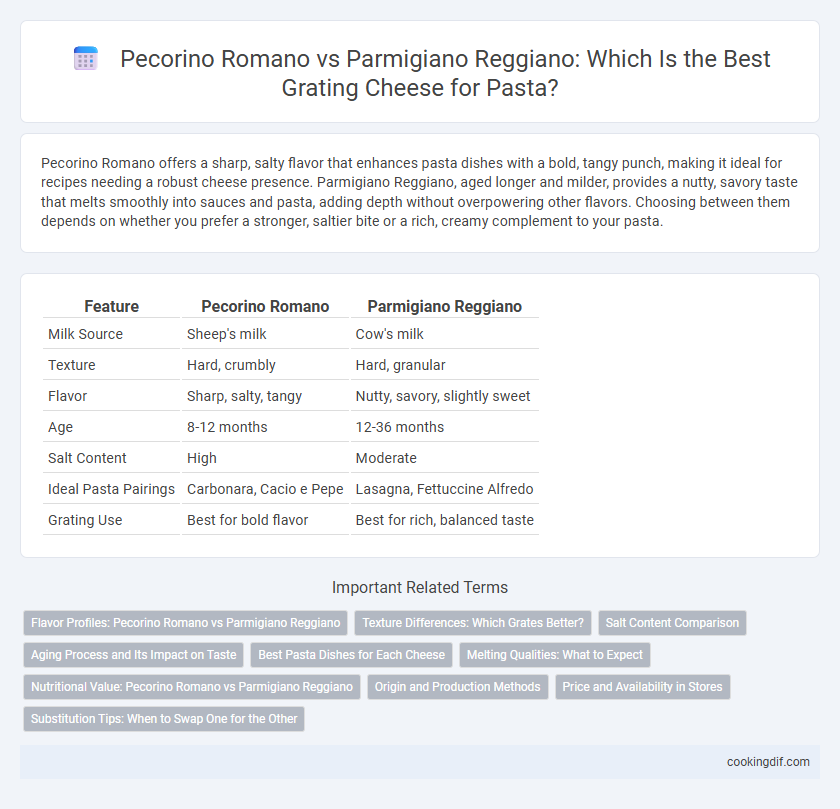Pecorino Romano offers a sharp, salty flavor that enhances pasta dishes with a bold, tangy punch, making it ideal for recipes needing a robust cheese presence. Parmigiano Reggiano, aged longer and milder, provides a nutty, savory taste that melts smoothly into sauces and pasta, adding depth without overpowering other flavors. Choosing between them depends on whether you prefer a stronger, saltier bite or a rich, creamy complement to your pasta.
Table of Comparison
| Feature | Pecorino Romano | Parmigiano Reggiano |
|---|---|---|
| Milk Source | Sheep's milk | Cow's milk |
| Texture | Hard, crumbly | Hard, granular |
| Flavor | Sharp, salty, tangy | Nutty, savory, slightly sweet |
| Age | 8-12 months | 12-36 months |
| Salt Content | High | Moderate |
| Ideal Pasta Pairings | Carbonara, Cacio e Pepe | Lasagna, Fettuccine Alfredo |
| Grating Use | Best for bold flavor | Best for rich, balanced taste |
Flavor Profiles: Pecorino Romano vs Parmigiano Reggiano
Pecorino Romano offers a sharp, salty, and tangy flavor profile with a distinct sheep's milk richness, making it ideal for bold pasta dishes like Cacio e Pepe. Parmigiano Reggiano provides a nutty, savory, and slightly sweet taste with a granular texture, complementing delicate sauces and enhancing umami depth. Both cheeses excel as grating options, but Pecorino Romano stands out for its robust intensity, while Parmigiano Reggiano delivers a balanced complexity.
Texture Differences: Which Grates Better?
Pecorino Romano features a harder, crumbly texture that grates into coarse, sharp shards, ideal for bold pasta dishes requiring strong flavor infusion. Parmigiano Reggiano has a slightly softer, granular texture that produces fine, fluffy flakes, perfect for delicate garnishing and smooth melting. When grating, Pecorino Romano is more efficient for robust, textured topping, while Parmigiano Reggiano excels in creating fine, airy cheese layers.
Salt Content Comparison
Pecorino Romano contains approximately 1,200 mg of sodium per 28-gram serving, making it significantly saltier than Parmigiano Reggiano, which has about 300 mg per the same serving size. This higher salt content in Pecorino Romano imparts a sharper, more intense flavor, ideal for dishes requiring a pronounced salty kick. Parmigiano Reggiano offers a milder taste with less sodium, making it suitable for those seeking a subtler seasoning in their pasta recipes.
Aging Process and Its Impact on Taste
Pecorino Romano undergoes an aging process of at least 8 months, resulting in a sharper, saltier, and more robust flavor ideal for bold pasta dishes. Parmigiano Reggiano ages from 12 to 36 months, developing a complex, nutty, and slightly sweet taste that enhances delicate pasta sauces. The aging duration directly influences the texture and intensity, with Pecorino Romano offering a crumbly, dry texture and Parmigiano Reggiano delivering a granular, melt-in-the-mouth experience.
Best Pasta Dishes for Each Cheese
Pecorino Romano's sharp, salty flavor enhances robust pasta dishes like Cacio e Pepe and Amatriciana, where its strong taste complements simple ingredients. Parmigiano Reggiano's nutty and savory profile pairs perfectly with creamy or vegetable-based pastas such as Fettuccine Alfredo and Risotto, adding depth without overpowering. Choosing the right cheese elevates the pasta's overall flavor profile, balancing richness and tanginess according to recipe tradition.
Melting Qualities: What to Expect
Pecorino Romano and Parmigiano Reggiano differ significantly in melting qualities, affecting their use as grating cheese for pasta dishes. Pecorino Romano has a higher salt content and a firmer texture that melts less smoothly, creating a slightly grainy finish ideal for robust, sharp-flavored sauces. Parmigiano Reggiano melts more evenly due to its balanced fat content and aged texture, resulting in a creamy, smooth consistency that enhances delicate pasta sauces.
Nutritional Value: Pecorino Romano vs Parmigiano Reggiano
Pecorino Romano contains higher levels of sodium and fat compared to Parmigiano Reggiano, making it richer and saltier, which impacts dietary considerations. Parmigiano Reggiano offers more protein and calcium per serving, supporting bone health and muscle maintenance. Both cheeses provide essential vitamins like vitamin A and B12, but Parmigiano Reggiano generally has a more balanced nutrient profile for regular consumption.
Origin and Production Methods
Pecorino Romano originates from Lazio, Sardinia, and Grosseto regions in Italy and is made from 100% sheep's milk, aged for at least eight months, resulting in a sharp, salty flavor ideal for grating over pasta. Parmigiano Reggiano, produced in Emilia-Romagna and Lombardy, uses cow's milk from specific local breeds and undergoes a lengthy aging process of 12 to 36 months, delivering a nutty and complex taste. Distinct production methods, including milk sourcing and aging duration, define their unique textures and flavor profiles suited for different pasta dishes.
Price and Availability in Stores
Pecorino Romano typically offers a lower price point compared to Parmigiano Reggiano, making it a more budget-friendly choice for grating cheese. Parmigiano Reggiano is widely available in most supermarkets due to its popularity and demand, while Pecorino Romano can sometimes be found more readily in specialty or Italian markets. Both cheeses provide distinctive flavors, but Pecorino Romano's higher salt content often appeals to those seeking a sharper taste at a competitive price.
Substitution Tips: When to Swap One for the Other
Pecorino Romano's sharp, salty flavor and crumbly texture make it ideal for bold pasta dishes like Cacio e Pepe, while Parmigiano Reggiano offers a nuttier, creamier profile suited for more delicate sauces. Substitute Pecorino Romano with Parmigiano Reggiano when a milder tang is desired, balancing intensity without overpowering the dish. For authentic Roman recipes, reserve Pecorino; for versatility and subtle depth, Parmigiano can be used confidently as a grating cheese alternative.
Pecorino Romano vs Parmigiano Reggiano for grating cheese Infographic

 cookingdif.com
cookingdif.com